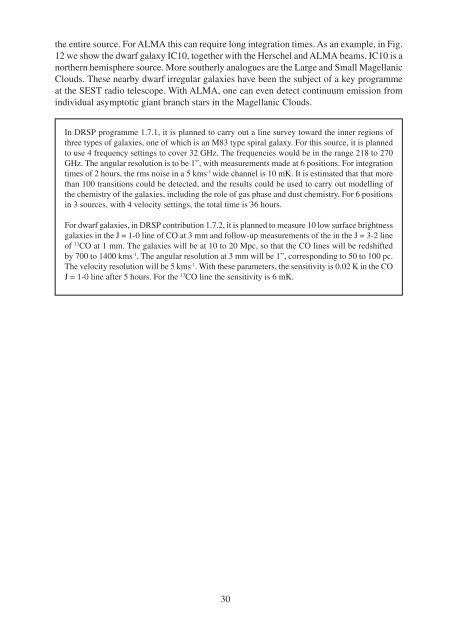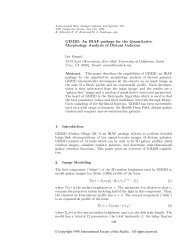4 Comparison of the ALMA and Herschel - ESO
4 Comparison of the ALMA and Herschel - ESO
4 Comparison of the ALMA and Herschel - ESO
You also want an ePaper? Increase the reach of your titles
YUMPU automatically turns print PDFs into web optimized ePapers that Google loves.
<strong>the</strong> entire source. For <strong>ALMA</strong> this can require long integration times. As an example, in Fig.<br />
12 we show <strong>the</strong> dwarf galaxy IC10, toge<strong>the</strong>r with <strong>the</strong> <strong>Herschel</strong> <strong>and</strong> <strong>ALMA</strong> beams. IC10 is a<br />
nor<strong>the</strong>rn hemisphere source. More sou<strong>the</strong>rly analogues are <strong>the</strong> Large <strong>and</strong> Small Magellanic<br />
Clouds. These nearby dwarf irregular galaxies have been <strong>the</strong> subject <strong>of</strong> a key programme<br />
at <strong>the</strong> SEST radio telescope. With <strong>ALMA</strong>, one can even detect continuum emission from<br />
individual asymptotic giant branch stars in <strong>the</strong> Magellanic Clouds.<br />
In DRSP programme 1.7.1, it is planned to carry out a line survey toward <strong>the</strong> inner regions <strong>of</strong><br />
three types <strong>of</strong> galaxies, one <strong>of</strong> which is an M83 type spiral galaxy. For this source, it is planned<br />
to use 4 frequency settings to cover 32 GHz. The frequencies would be in <strong>the</strong> range 218 to 270<br />
GHz. The angular resolution is to be 1”, with measurements made at 6 positions. For integration<br />
times <strong>of</strong> 2 hours, <strong>the</strong> rms noise in a 5 kms -1 wide channel is 10 mK. It is estimated that that more<br />
than 100 transitions could be detected, <strong>and</strong> <strong>the</strong> results could be used to carry out modelling <strong>of</strong><br />
<strong>the</strong> chemistry <strong>of</strong> <strong>the</strong> galaxies, including <strong>the</strong> role <strong>of</strong> gas phase <strong>and</strong> dust chemistry. For 6 positions<br />
in 3 sources, with 4 velocity settings, <strong>the</strong> total time is 36 hours.<br />
For dwarf galaxies, in DRSP contribution 1.7.2, it is planned to measure 10 low surface brightness<br />
galaxies in <strong>the</strong> J = 1-0 line <strong>of</strong> CO at 3 mm <strong>and</strong> follow-up measurements <strong>of</strong> <strong>the</strong> in <strong>the</strong> J = 3-2 line<br />
<strong>of</strong> 13 CO at 1 mm. The galaxies will be at 10 to 20 Mpc, so that <strong>the</strong> CO lines will be redshifted<br />
by 700 to 1400 kms -1 . The angular resolution at 3 mm will be 1”, corresponding to 50 to 100 pc.<br />
The velocity resolution will be 5 kms -1 . With <strong>the</strong>se parameters, <strong>the</strong> sensitivity is 0.02 K in <strong>the</strong> CO<br />
J = 1-0 line after 5 hours. For <strong>the</strong> 13 CO line <strong>the</strong> sensitivity is 6 mK.<br />
30




